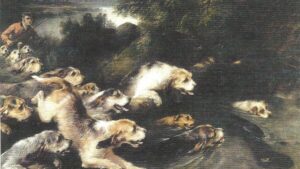
The Grand Basset Griffon Vendéen Then & Now
Discover the remarkable journey of the Grand Basset Griffon Vendéen to AKC recognition, spanning 15 years. Read more.

Home » Dog Breeds » Grand Basset Griffon Vendéen Dog Breed
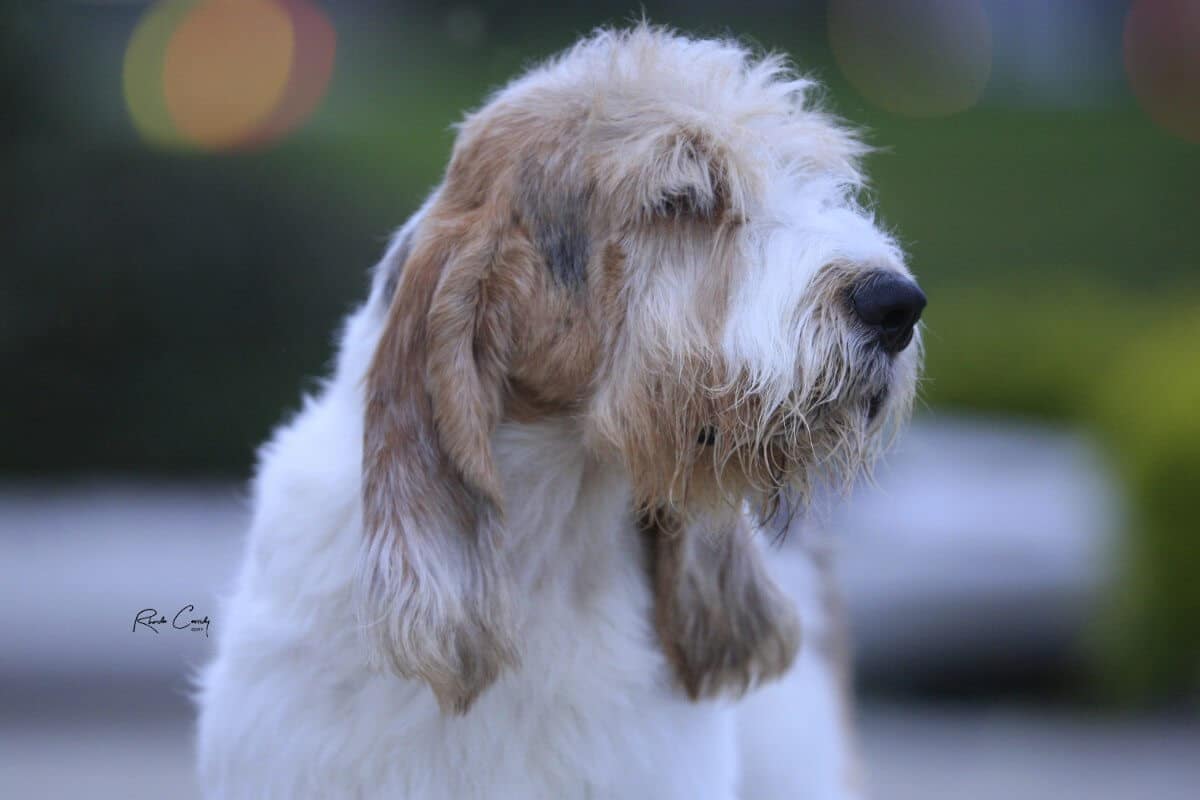
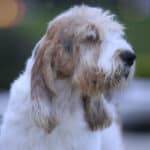
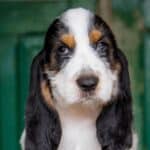
The Grand Basset Griffon Vendéen (GBGV) is a distinct and elegant French hound known for its tenacity as a hunter and its friendly demeanor with everyone it meets. A member of the Basset family, the GBGV is a larger version of the Petit Basset Griffon Vendéen (PBGV). Recognized for its rough coat and dignified expression, the breed is not only a skilled worker in the field, it is also an affectionate companion in the home.
Hound
15.5 – 18 Inches
40 – 45 Pounds
13 – 15 Years
| Country of Origin | France |
|---|---|
| Bred For | Small and Big Game Hunting, Companionship |
| Known For | Long Ears, Rough Coat, Friendly Disposition |
| Popularity | Low |
| Temperament | Happy, Independent, Outgoing |
| Activities | Pack Hunting, Running, Hiking, Conformation Shows, Dog Sports |
The Grand Basset Griffon Vendéen traces its roots back to the rugged landscape of the Vendée region in Western France. These hounds were cultivated over centuries to possess the stamina and determination required to hunt game over the region’s challenging terrain.
Historically, the GBGV shared its origins with the smaller Petit Basset Griffon Vendéen. The two breeds were only distinguished by size and were bred for different game – the larger GBGV often pursued larger prey like the roe deer, while the smaller hound focused its pursuits on hares and rabbits.
Through the years, breeders carefully selected dogs with the best scenting abilities, intelligence, and resilience to ensure the breed’s proficiency as a hunter. Over time, this selective breeding produced the distinct appearance and character traits associated with the GBGV today.
The breed’s value, however, was not limited to hunting. The GBGV, with its affable nature and distinctive looks, soon found its way into homes as a loyal companion. This allowed the breed’s popularity to grow not only in France but also abroad.
The Grand Basset Griffon Vendéen ultimately received official recognition by major kennel clubs and registries, further solidifying its status within the dog world. The American Kennel Club (AKC) granted the GBGV official recognition in 2018. Additionally, given its European roots, the Fédération Cynologique Internationale (FCI) has long recognized and celebrated the breed, and in the United Kingdom, The Royal Kennel Club (UK) has also championed the unique qualities and heritage of the GBGV.
The Grand Basset Griffon Vendéen’s rich history is a testament to its adaptability and its many charms. From the rough Vendée region to today’s modern landscapes, the GBGV has reliably embodied its remarkable versatility and its many endearing qualities wherever it has been admired.
Mature Grand Basset Griffon Vendéens typically stand between 15.5 and 18 inches tall at the shoulder.
In terms of weight, adult GBGVs generally weigh from 40 to 45 pounds.
The Grand Basset Griffon Vendéen is a well-balanced dog, with a body that is slightly longer than it is tall. This elongated form is not excessive and should never detract from the breed’s natural agility and speed. The GBGV possesses solid bone, ensuring strength without clunkiness. The breed’s overall composition speaks to its history as a determined and resilient hunting dog, capable of navigating challenging terrain with ease.
Texture: The Grand Basset Griffon Vendéen boasts a rough coat of medium length, providing this hound with an unmistakable ruggedness. The breed’s noble head sports a beard and mustache, as well as long, protective eyebrows. The double coat is both aesthetically pleasing and functional, as it offers protection against brambles and harsh weather conditions that are often encountered during a hunt.
| Standard Color | |
|---|---|
| White & Black | ee |
| White & Gray | ee |
| White & Grizzle | ee |
| White & Lemon | ee |
| White & Orange | ee |
| White & Sable | ee |
| White Black & Tan | ee |
| Black & Tan | ee |
| Fawn | ee |
Markings: None
A Note About Color: The GBGV’s colorful coat is harsh and straight, with a casual appearance that requires no scissoring or sculpting. Color may be white with any other colors (tri-color), white with any other color (bi-color), or black and tan. Solid colors are not acceptable in the GBGV.
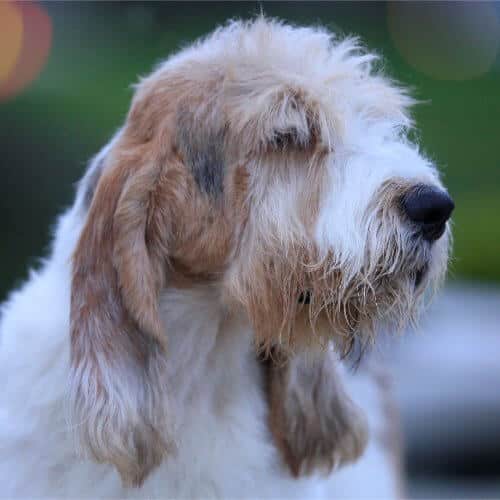
The tail of the Grand Basset Griffon Vendéen is thick at the base, tapering as it extends towards the tip. Set high, the tail is carried proudly, often with a slight curve but never curled over the back. When the hound is in motion, especially during a hunt, the tail is held high, making it easily visible in tall grass or rough cover.
The tail is covered with rough hair similar to that on the rest of the body. It can sometimes be slightly bushier than the rest of the coat, adding to the tail’s prominence. The GBGV’s tail has a saber-like shape and is never docked.
Owning a Grand Basset Griffon Vendéen is a rewarding experience, as these hounds bring both charm and vitality to a household. However, potential owners should be prepared for the breed’s specific needs in order to maintain a healthy and happy dog and to foster a harmonious relationship.
The Grand Basset Griffon Vendéen is generally a robust and healthy breed, inheriting the resilience of its hunting ancestors. Regular veterinary check-ups and a balanced diet play a crucial role in maintaining its health and well-being.
Lifespan: The average lifespan of a GBGV is around 13 to 15 years. However, with proper care and attention, some individuals can live beyond these years, enjoying a ripe old age with vigor.
Like all breeds and mixed breeds, individual Grand Basset Griffon Vendéens can be susceptible to certain health conditions. While not all will experience these challenges, it is essential to be aware of them:
It’s crucial for Grand Basset Griffon Vendéen owners to schedule regular veterinary check-ups that will provide early detection and treatment of any illness. A proactive approach to health, combined with a balanced diet and regular exercise, can significantly contribute to a dog’s overall well-being.
The Grand Basset Griffon Vendéen possesses a character that is charming and lively, making these happy and outgoing hounds delightful companions for families and individuals alike.
For those who are new to dog ownership, the GBGV can be a suitable choice, as the breed’s friendly demeanor and adaptable nature make it relatively straightforward to care for. However, novice owners should be prepared to handle the breed’s sometimes stubborn and independent streak, a trait inherent to many scenthound breeds.
In terms of sensitivity, the GBGV ranks as only moderately reactive. These hounds can be both independent and affectionate, forming strong bonds with their human companions while also enjoying moments of blissful solitude.
A GBGV is usually amiable towards other dogs, largely owing to its pack-hunting background. The breed’s sociable nature often translates well to multi-dog households, although early socialization is always beneficial.
The friendly disposition of the GBGV extends to children, making it an excellent choice as a family dog. The breed generally enjoys the playful energy of younger kids, though it is always recommended that interactions between children and dogs be supervised.
When it comes to strangers, the Grand Basset Griffon Vendéen’s response can vary. Some hounds may be somewhat reserved, whereas others will be more welcoming. Either way, early socialization can help with preparing a GBGV to demonstrate a balanced reaction when meeting new people.
Feeding the Grand Basset Griffon Vendéen requires a well-thought-out approach to maintain this hound’s health, energy, and optimal weight. The breed’s active nature, combined with its robust constitution, requires a diet that fuels its energy needs.
When feeding a GBGV puppy, it’s essential to provide a diet specifically formulated for growing dogs. Puppies typically require more frequent meals – often three to four times a day – to support their rapid growth and high energy levels.
As the GBGV transitions into adulthood, its dietary needs change. Adult GBGVs will usually thrive on two meals a day. The amount of food given will vary based on the dog’s age, weight, activity level, and the specific brand of food. On average, a typical adult GBGV might consume between 1.5 to 2.5 cups of high-quality dog food daily. However, it’s always best to consult the feeding guidelines on the dog food package or discuss with a veterinarian to determine the ideal quantity.
It’s essential to monitor the Grand Basset Griffon Vendéen’s weight and adjust feeding amounts as necessary. Overfeeding can lead to obesity, which can bring about a slew of health issues. On the flip side, underfeeding or providing a diet lacking in essential nutrients can result in an undernourished and lethargic dog.
Training a Grand Basset Griffon Vendéen offers a unique experience, combining the joys of working with an intelligent breed and the occasional challenge presented by its independent nature.
The GBGV is undoubtedly an intelligent breed, often displaying a keen understanding of commands and tasks. However, their hound lineage means these dogs can sometimes be guided by their noses and instincts, leading them to momentarily ignore commands, especially if an intriguing scent captures their attention.
Early training and socialization are vital for the GBGV. Being introduced to various environments, people, and other animals during their formative months will shape them into becoming well-rounded adults. It’s also during this time that basic obedience commands can be introduced.
When training a GBGV, consistency is crucial. The breed’s occasional stubborn streak can be countered with patience and positive reinforcement techniques. Using treats, praise, and play as rewards often yields the best results.
Regarding vocal tendencies, the GBGV might express itself with barking, especially if they pick up on intriguing scents or if they’re left alone for extended periods. Addressing excessive barking early on can prevent any unnecessary vocalization from becoming a habitual behavior.
Roaming can be another trait inherent in some GBGVs. A securely fenced yard or leash walks are recommended to ensure the errant hound doesn’t get led astray by its superb nose.
Lastly, the Grand Basset Griffon Vendéen’s natural instincts might lead these hounds to chase smaller animals, a trait known officially as predation. Early training and socialization can help to manage this behavior, but owners should always be cautious when introducing a GBGV to new pets, especially smaller ones.
Engaging a Grand Basset Griffon Vendéen in regular physical activity is essential for its overall health and well-being, and to keep the hound’s intelligent mind stimulated.
| Energy Level | High |
|---|---|
| Exercise Requirements | 2 Hours/Day (Minimum), Daily Walks, Vigorous Running, Regular Exercise, Playing with Another Dog, Mental Stimulation |
The GBGV is an active and energetic breed, deriving from its history as a hunting dog. While these hounds don’t require the level of exercise of some high-energy breeds, they still benefit from consistent daily activity.
Long walks, coupled with playtime in a secured yard, often suffice to keep a GBGV content. When out for a walk, it’s crucial to keep these dogs on a leash due to their inherent tracking instincts. Given the chance, they might chase after an interesting scent, making recall a real challenge.
In terms of intensity, GBGVs are a moderate breed. These hounds typically enjoy periods of play and can exhibit bursts of energy, especially during their younger years. However, they’re also known to appreciate lounging around with their family after a good exercise session.
Playfulness is an innate characteristic of the Grand Basset Griffon Vendéen. These affable dogs often enjoy participating in games of fetch and tug-of-war, and even agility exercises. Engaging them in such activities not only provides physical stimulation, it also offers an excellent bonding opportunity for both hound and human.
Maintaining the unique and rustic coat of the Grand Basset Griffon Vendéen requires regular grooming, but it doesn’t have to be a daunting task.
| Coat Type | Harsh, Straight, Medium Length, Protective |
|---|---|
| Grooming Requirements | Weekly Brushing, Occasional Bathing, Routine Ear Cleaning, Periodic Nail Trimming, Regular Tooth Brushing |
The breed’s coat is rough and straight, providing a degree of protection against brambles and harsh weather when they’re outdoors. This texture means they don’t need frequent baths unless they get particularly dirty. Overbathing can strip the coat of its natural oils, so it’s best to bathe the GBGV only when it’s necessary.
In terms of shedding, the GBGV is a moderate shedder. Regular brushing, ideally a couple of times a week, will help to remove any loose hairs, keep the coat free of tangles, and distribute the skin’s natural oils, promoting a healthy shine. During shedding seasons, usually in the spring and fall, more frequent brushing might be needed to manage the increased hair loss.
It’s also essential to check the GBGV’s long ears regularly. Due to their drooping nature, they can be prone to infections. Cleaning them with a vet-recommended solution and making sure they’re always dry will help to prevent potential issues from taking hold in the ear canals.
Beyond coat care, other grooming essentials include trimming the Grand Basset Griffon Vendéen’s nails regularly, making sure they don’t become too long or cause discomfort. Regular dental care, like brushing the teeth or providing dental chews, will promote good oral health and fresh breath.
Welcoming a Grand Basset Griffon Vendéen into the home entails understanding and catering to the specific needs of the breed, ensuring that everyone enjoys a harmonious coexistence.
For apartment dwellers, the good news is that a GBGV can adapt to apartment living provided the dog receives adequate exercise daily. The breed’s moderate energy level means that, after a good walk or play session, these hounds are usually content to lounge around the house. However, a home with a yard provides an additional space for them to explore and play, given their natural curiosity and love for simply sniffing around.
In terms of weather adaptability, the breed’s coarse coat offers protection against colder temperatures, and these hounds generally handle cooler climates quite well. That said, it’s always essential to provide shelter and warmth during extremely cold periods. On the flip side, their coat can also serve as a barrier against sunburn in hot weather, so they should be protected from extreme heat. It’s important, however, to always make sure they have access to shade and fresh water, especially during the hotter months.
The Grand Basset Griffon Vendéen’s sociable nature means these dogs thrive in a family environment and prefer being involved in family activities rather than being left alone during the day. Their friendly disposition often makes them suitable companions for children, but as with all dogs, interactions with kids should always be supervised.
The arrival of Grand Basset Griffon Vendéen puppies is an exciting time for everyone involved, filled with boundless energy, playful antics, and moments of pure joy. These pups, with their large eyes and floppy ears, are undeniably adorable, but raising each one also comes with responsibilities for providing the best start in life.
From the moment a GBGV puppy opens its eyes to the world, its inquisitiveness is evident. However, the pup’s physical and emotional growth requires special attention during the first weeks, month, and year.
Diet is paramount during this stage. It is important to make sure the GBGV pup receives nutritionally balanced meals that are designed specifically for puppies. This diet will support its growth and overall development. It is also essential to follow the feeding guidelines provided by the puppy’s breeder or a veterinarian to prevent feeding too much or too little.
Socialization plays a pivotal role during the puppy’s early months. Introducing the GBGV pup to various environments, people, and other animals helps to building confidence and reduces the chances of becoming timid and withdrawn later in life.
While a GBGV puppy is filled with plenty of energy, it is crucial to make sure its playtime isn’t too rough, as the pup’s growing bones and joints are still delicate. Gentle play and age-appropriate toys can keep it engaged without risk of injury.
Training should begin early, capitalizing on the puppy’s eagerness to learn while establishing a solid foundation for future training sessions. Using positive reinforcement techniques, such as treats and praise, can make the process smoother and more enjoyable for both the puppy and its favorite people.
Regular veterinary check-ups, vaccinations, and preventive treatments against parasites are essential to safeguard the young Grand Basset Griffon Vendéen’s health during those initial months.
The Grand Basset Griffon Vendéen is a breed that thrives when engaged in activities that challenge both its body and mind. The breed’s history as a scenthound, originally bred for hunting in the challenging terrain of the Vendée region of France, has endowed these hounds with traits that make them well-suited for various activities. Some of the dog sports that can provide an outlet for a GBGV include:
It’s always crucial to choose activities that align with the dog’s age, health, and temperament. Proper training and positive reinforcement can deepen the bond between the dog and its owner while providing mental and physical stimulation for both.
The Grand Basset Griffon Vendéen is recognized by the world’s leading registries and kennel organizations, which categorize the breed into a specific Group based on its unique characteristics. This breed is recognized worldwide under the following Group designations:
| Organization | Group Designation |
|---|---|
| AKC (American Kennel Club) | Hound |
| UKC (United Kennel Club) | Scenthound |
| CKC (Canadian Kennel Club) | Hounds |
| ANKC (Australian National Kennel Council) | Hounds |
| RKC (The Royal Kennel Club) | Hound |
| FCI (Fédération Cynologique Internationale) | Group 6: Scent Hounds and Related Breeds; Section 1.3.: Small-Sized Hounds |
The ideal Grand Basset Griffon Vendéen is described by a Breed Standard that is approved by each of the world’s leading registries and kennel organizations. The Breed Standards for this breed may be found in the following links:
| Organization | Breed Standard |
|---|---|
| American Kennel Club | AKC Grand Basset Griffon Vendéen Breed Standard |
| United Kennel Club | UKC Grand Basset Griffon Vendéen Breed Standard |
| Canadian Kennel Club | CKC Grand Basset Griffon Vendéen Breed Standard |
| Australian National Kennel Council | ANKC Grand Basset Griffon Vendéen Breed Standard |
| The Royal Kennel Club | RKC Grand Basset Griffon Vendéen Breed Standard |
| Fédération Cynologique Internationale | FCI Grand Basset Griffon Vendéen Breed Standard |
The Grand Basset Griffon Vendéen has captured the hearts of many purebred dog enthusiasts worldwide. This affection and dedication to the breed have led to the establishment of a number of breed-specific clubs. These organizations work diligently to preserve the breed’s heritage, promote its unique qualities, and offer support to both seasoned breeders and new enthusiasts alike.
In the United States, the Grand Basset Griffon Vendéen Club of America serves as the primary organization dedicated to the breed. The club’s members provide valuable resources on the Breed Standard and useful information on healthcare, training tips, and social and competitive events. By organizing shows, trials, and educational programs, the club strives to raise awareness and appreciation for the GBGV.
In the United Kingdom, the Basset Griffon Vendéen Club stands as a beacon for enthusiasts of both the Petit and Grand breeds. The club plays a crucial role in fostering appreciation for the GBGV, promoting responsible breeding, celebrating the breed’s achievements in various canine disciplines, and offering guidance to GBGV owners. The dedicated efforts of its members ensure that the breed’s rich legacy and distinctive charm are upheld and celebrated across Great Britain.
While the Grand Basset Griffon Vendéen is adored by many, there are instances in which these dogs may find themselves in need of a new home.
In the United States, the Grand Basset Griffon Vendéen Club of America takes on a significant role in aiding GBGVs that require assistance. Beyond promoting and celebrating the breed, the club is also involved in rescue efforts, ensuring GBGVs in need find the loving homes they deserve.
Similarly, in the United Kingdom, the Basset Griffon Vendéen Club is dedicated to the wellbeing of both the Petit and Grand Basset Griffon Vendéen. The club’s commitment extends beyond mere promotion; its members actively assist GBGVs in distress, facilitating their placement in suitable and caring homes.
Beyond these organizations, local shelters and animal rescue organizations might also have a GBGV that’s up for adoption. For individuals considering introducing a GBGV into their home, reaching out to both the breed clubs and local shelters can be a rewarding way to provide a loving dog with a second chance.
Yes, Grand Basset Griffon Vendéens shed, but not excessively. Their rough and medium-length coat will shed periodically throughout the year, especially during seasonal changes in the spring and fall months. Regular grooming can help to manage and reduce the amount of hair that’s shed.
While the Grand Basset Griffon Vendéen isn’t classified as a traditional “water dog,” these dogs can enjoy occasional play in the water. However, their primary purpose historically has been as a scenthound, tracking game on land rather than retrieving in water.
Grand Basset Griffon Vendéens, being hounds, have a characteristic vocal nature. They might bark or howl, especially if they pick up an interesting scent or hear peculiar sounds. Proper training and socialization from an early age can help with managing their barking tendencies.
The Grand Basset Griffon Vendéen, with its friendly and sociable nature, can make a delightful addition in a family setting. They generally get along well with children and can form strong bonds with family members. However, like all breeds, early socialization and consistent training are essential to ensure they become well-rounded family pets.
In terms of grooming, the GBGV is relatively low maintenance, requiring regular brushing but not frequent baths. However, they need consistent training and ample exercise to keep them mentally stimulated and physically active, which makes them a moderate maintenance breed overall.
It’s not advisable to leave a GBGV alone for extended periods. Like many dogs, this breed thrives on human companionship and can develop separation anxiety or unwanted behaviors if left alone for too long. If circumstances require a GBGV to be alone, providing plenty of safe toys and a comfortable environment is crucial.
Absolutely! The GBGV has historically been used as a scenthound, adept at tracking game like hare and deer over tough, challenging terrain. The breed’s keen sense of smell and agile body make these hounds excellent hunting companions, especially in pack hunting scenarios.
While the primary roles for the Grand Basset Griffon Vendéen have been hunting and companionship, with the right training, these noble hounds can be adapted to service roles. Their intelligence and amiable nature might even make them suitable for certain service tasks. However, it’s always best to evaluate individual dogs for aptitude before committing them to a career as a service dog.

Discover the remarkable journey of the Grand Basset Griffon Vendéen to AKC recognition, spanning 15 years. Read more.
The best way to ensure a long and happy relationship with a purebred dog is to purchase one from a responsible breeder. Not sure where to begin?
Contact the National Parent Club’s Breeder Referral Program, which is listed on the AKC Breeder Referral Contacts page.
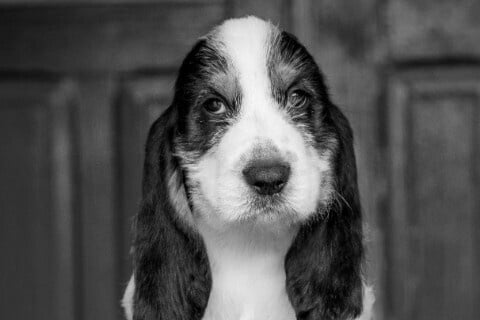

"*" indicates required fields
Showsight Magazine–the world’s most influential purebred dog publication since 1992. Each issue reaches a global audience dedicated to preserving the history and health of purpose bred dogs. Filled with award-winning editorial focused on news and insights from the dog show community, top breeders, handlers, AKC Judges, and more!